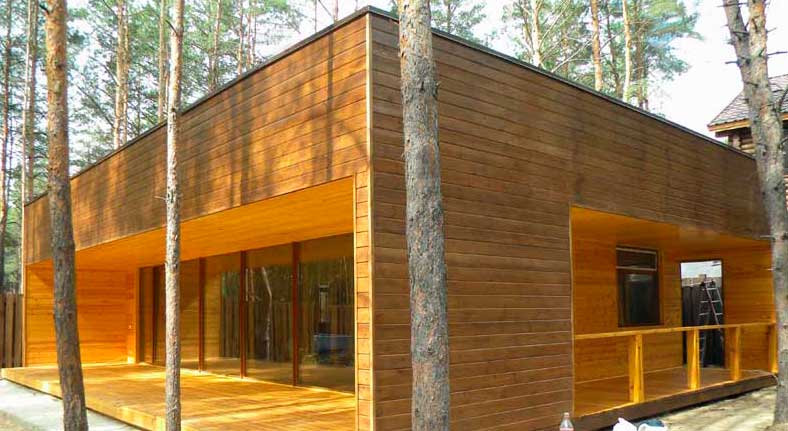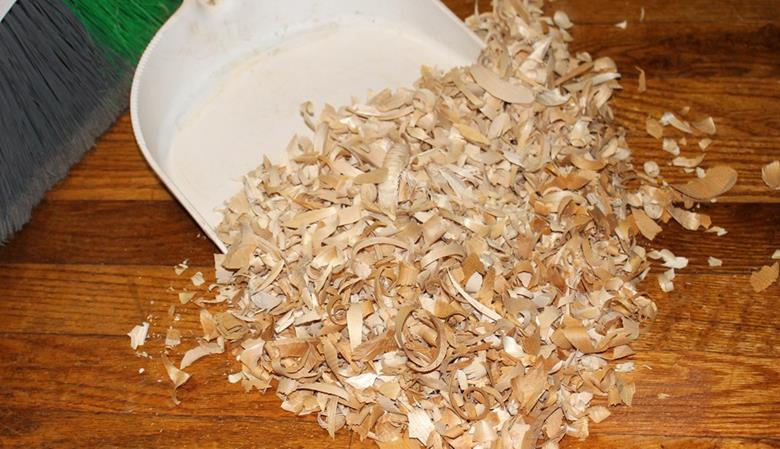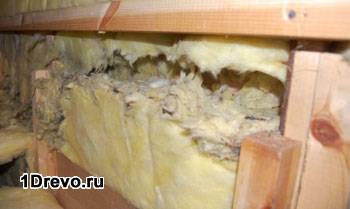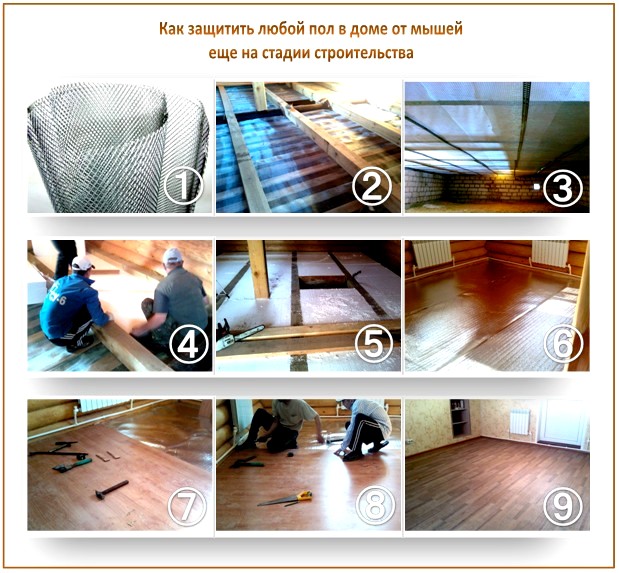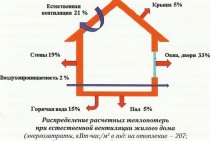Ultrasonic generators
What to do if the house has already been built, and despite all the preventive actions, it was nevertheless attacked by rodents? There are many proven ways to eliminate mice, among which a very effective and environmentally friendly one is the use of ultrasonic repellers. These are devices whose principle of operation lies in the emission of sound waves that are not audible to the human ear. At the same time, rodents clearly hear an unpleasant sound that forces them to leave the area of impact of the device. Such devices are effective not only against mice - the installation of an ultrasonic repeller can also save the area from larger rodents - rats, moles and other pests.
The presence of a cat in the house, and preferably several, can be a prevention of the appearance of small pests. Everyone knows with what pleasure hunting cats exterminate rodents. Indeed, even the smell of a predator repels rodents. But this doesn't always work. You may come across such a cat that will live in the same territory with mice in complete harmony, without causing them any harm. The natural enemies of small rodents are weasels, ermines. Several of these domesticated animals are able to quickly clear the house of mice.
Disadvantages of frame houses
Naturally, there are also disadvantages in frame-type structures. Even at the design stage, it is necessary to responsibly approach the selection of materials used. So, an attempt to save money can lead to the use of low-quality Chinese materials, for example, OSB-3 boards. In the manufacture of such boards, phenol-formaldehyde resins act as a binder. If the formaldehyde emission class is from E2 or more, then this substance will actively evaporate into the room air, which poses a danger to human health. Materials with a zero emission class are considered safe.
Mineral short-fiber wool and poor quality basalt wool are a source of carcinogenic dust. Thus, the correct selection of materials used in construction will become a guarantee of a high-quality and healthy life for people living in a frame house.
In addition, frame houses are classified as wooden. This indicates an increased fire hazard. This drawback can be eliminated by using fire-resistant materials: special drywall, fireproof panels from LSU, DSP. The beams from which the frame is made must be impregnated with fire-resistant impregnations. Expanded polystyrene is selected class G1 or G2. The disadvantages include the low vandal resistance of such houses. The walls of a frame house can be destroyed by one person with a chainsaw, which cannot be done with stone walls. In addition, the materials of the frame and other structural elements are defenseless against the attack of small pests - mice, rats. This seemingly insignificant fact can make a person's life in the house absolutely unbearable. Rodents gnaw holes and tunnels in the insulation material, destroy expanded clay and glass wool, and can live in the walls of a frame house for a long time. This problem is especially relevant when, during the construction of the house, low-quality foam was used as a heater.
Reasons for the penetration of rodents into a frame house
In order to develop effective methods of struggle, you need to understand the motives of the animals. Perhaps then it will be easier to deal with them.
The main reason is the search for food. Rodents especially favor various cereals, which attract pests, as if with a magnet.
The second is the search for a warm place to live. If you live in an area where there are quite cold winters, then be sure - with almost one hundred percent probability you have small neighbors.
Frame houses are an easily accessible target for rodents. They are happy to settle inside the walls and under the floor. They are especially happy with the heater. The latter is laid between drywall and walls. Mice arrange their minks in it and live happily ever after.
Other Methods
The struggle of man against rodents has been going on for many centuries. People are constantly coming up with new ways to protect their home and property from damage by pests. So, burnt wooden blocks, branches are laid under the floor covering. The smell of burnt wood repels mice. In addition, other aromatic repellers can be used - these are pine, mint, tobacco added to the insulation. Red hot peppers are poured around the perimeter of the house and, if possible, into the walls. It is also known that rodents do not tolerate the smell of burning wool. The old method - they put a piece of wool in an old unnecessary saucepan, make several holes in the saucepan and set fire to the wool, then this container is placed in the basement. The smell of smoke will slowly spread throughout the house, driving pests away.
Although the concept of building a frame house is not at all new and has been familiar for centuries, this method of construction has gained particular fame in recent years. Firstly, the growing need for affordable and high-quality personal housing and, secondly, the emerging manufacturing technologies of the current construction manufactories make it possible to produce a frame house on a high-quality and environmentally friendly
Heaters and rodents is there a solution
Let's clarify right away - most modern floor heaters do not really eat mice, but at the same time they live quietly in them. And in soft ones they also make nests.
An interesting fact: the teeth of mice grow throughout their lives. Moreover, if the mouse does not constantly gnaw something, then these teeth will grow into the upper jaw. Therefore, chewing is a daily need for this animal. And the mouse can sharpen even concrete walls.
Especially often, mice start up, oddly enough, in the foam. Moreover, they gnaw it - but not in order to get enough, but in order to build comfortable nests in it. And therefore, manufacturers recommend insulating walls and floors with ecowool, which is looser and creates an antiseptic environment. But her mice also gnaw, although not so willingly.
Indeed, as practice shows, under the floor, mice can wind up in ecowool, and in polystyrene, and almost any other insulation. Even in glass wool! True, it is worth noting that it is very difficult, almost impossible, to gnaw through ordinary plywood and OSB boards with a mouse. All because of the peculiarities of the structure of her teeth. As well as boards, which have a layered structure with wood chips directed in different directions.
The secret of the survival of these animals in any conditions is their extreme unpretentiousness. That's why they gnaw their holes in anything, in a word.
What harm do rodents do?
Mice, rats and other rodents, in the absence of certain protective measures, can easily enter a frame house. By this they not only frighten the hosts, who are afraid or disdainful of such guests, but also bring harm. Destruction can befall any corner of the home. They gnaw through concrete or wiring, a wide variety of items in the house. Often pests destroy stocks for the winter or other food.
If mice settle in basements, where it is usually damp and dark, they begin to actively multiply. In this case, it is even more difficult to deal with their huge number. The most dangerous thing is that rodents are carriers of dangerous infectious diseases, such as cholera, various intestinal diseases, leptospirosis.
Therefore, it is necessary to get rid of them as soon as possible, and for this we will get acquainted with the methods of dealing with mice.
The main methods of protecting frame houses from rodents
-
Ecowool
, used as a heater, laid in the floor coverings of the lower floor, will protect against the appearance of mold, fungus, insects and rodents.Ecowool, consisting of 80% recycled cellulose and 20% a mixture of boric acid and borax, is an excellent antiseptic for wood and repels insects and rodents. -
Borax or lime solution
, which can process building blocks. - The old way of dealing with rodents, which our ancestors have long used: adding ash, slag, tobacco dust, dry mint or wormwood to the insulation.
-
Mechanical protection
: a monolithic reinforced concrete slab laid in the foundation will become a reliable barrier for rodents. You can use a cheaper option: a fine-mesh metal mesh laid in places where rodents can enter.
Consider in more detail how you can protect your home from the invasion of rodents.
Insulation against rodents
First of all, you should not use cheap insulation such as foam. Its choice is usually due to its low cost, but expanded polystyrene, although it has good thermal insulation properties, cannot become a protection against rodents. The best option, as mentioned above, is ecowool. It will serve as an excellent protection against any kind of biological aggression, protect against the appearance of mold, fungus, insects and rodents. At the same time, it is completely safe for humans, its components are non-toxic and non-volatile, they cannot get into the human respiratory organs with dust. In addition, it has excellent heat and sound insulation characteristics.
A feature of ecowool is that it is produced as a building material not in the usual rolls or mats, but in loose form. Its installation requires special equipment and some professional skills. On the other hand, the way it is laid - blowing out, allows you to leave no gaps and voids.
Expanded clay floor will protect against rodents
Expanded clay is an insulating material obtained from fired clay. It is used for quick backfilling, including when laying the floor. In order to protect against the appearance of rodents, a layer of expanded clay is required at least 30 cm. Expanded clay is laid on the soil and covered with plastic wrap. Two layers of OSB-3 are laid on top. Oriented strand board is impregnated with synthetic wax and boric acid, which should repel rodents. Another layer of expanded clay is laid on the OSB and the subfloor is ready.
Metal grid
A fine-mesh metal mesh with 5x5 mm cells can be laid along the subfloor or lined from below it. Another option for using mesh can be to wrap the plinth. The height of the grid in this case should be at least one meter; the grid is laid under the basement sheathing. Another metal method of protection is the sheathing of the foundation with a profiled sheet.
Preventing the appearance of rodents in a private house is much easier than fighting them, trying to get them out.
How to protect a building from rodents
One of the most serious dangers that lie in wait for wooden houses is the invasion of rodents.
This applies not only to timber and log buildings, but also to frame buildings: mice and rats make moves in the insulation, destroying the wall, in addition, if measures are not taken, there will be more and more of them over time. One vole mouse can bring up to 600 cubs per year, and such an invasion can bring a lot of inconvenience to residents.
How to protect a wooden house from rodents? In pest control, you have to use a comprehensive set of tools: this applies both to the design features of the house and to permanent support measures. You can use the following methods of struggle:
The right choice of heater. Rodents quickly destroy polystyrene foam, in some cases they can arrange nests even in basalt wool. Ecowool becomes an ideal, albeit expensive solution: it is able to completely occupy all the cracks, and rodents will not touch it.
In addition, it becomes a truly effective barrier to resist the cold. However, it is laid with the help of special equipment, and without the help of professionals, this work cannot be done.
- Arrangement of expanded clay layer during floor insulation. This is one of the most effective ways to protect a wooden house from mice. A 10-centimeter layer of expanded clay will protect the subfloor, and the mice will not gnaw on the floor beams.
- Wrapping the plinth and laying metal mesh under the floor. It will protect the building from the penetration of rodents and will become a completely effective barrier for a long time. However, this should not be the only control measure: rats are very smart animals, and sometimes they find a way around the obstacle.
Additional protection measures include various impregnations of wood with biocides, laying out poisoned bait, setting mousetraps, and other methods. To many, they seem inhumane, but mice and rats still have to be fought. The safest method for pests is the installation of ultrasonic repellers, these devices are harmless to humans, and they effectively scare away rodents from the site.
The use of poisoned baits is not always safe: pets left unattended can suffer from them. To avoid trouble, you need to choose poisons with a very bitter taste: a cat or dog will not eat such a bait, and a mouse will not pay any attention to the taste.
Protecting the building from insects
Another problem that threatens a wooden house is insects. Carpenter beetles, termites, ants - this is just a short list of representatives of the order of insects who are not averse to feasting on wood and natural insulation.
How to protect a wooden house from beetles? The most effective method is still the use of chemical antiseptics and other substances:
Rodent protection under construction
Why at this stage? Yes, because it is much easier to prevent the invasion of rodents than to fight them later. And the myths that there are no barriers for those who want to get into the house of mice are still myths. With a creative and careful approach to this issue, you can completely ensure that such an attack never starts in your house or bath.
But first, you can carefully study the current building codes and regulations, which list gratings, metal screens and other methods of protection. But remember, when installing a metal profile from mice, it is imperative to leave a gap - so that the insulation does not get wet from condensate.
Method # 1 - expanded clay castle
Here we are talking about the so-called "expanded clay castle", when the expanded clay layer is laid especially tightly and at least 10 cm thick. Here is a standard floor cake that is protected from mice during the construction of the house:
- 1st layer: we lay expanded clay (baked clay) directly on the ground. The layer should be at least 30 cm. Cover with plastic wrap.
- 2nd layer: lay two layers of OSB-3 boards.
- 3rd layer: put expanded clay again.
- 4th layer: cover with oriented strand boards impregnated with synthetic wax and boric acid. These substances repel rodents well.
As you can see, nothing complicated.
Method # 2 - fine mesh
The simplest and most effective way of mechanical protection against mice even at the construction stage can be called a galvanized mesh. It should be made of durable metal and with small cells. Much smaller than what you are currently imagining. Now let's explain why: the skull of a mouse has the property of "folding" like a newborn's, and therefore this animal will really crawl through "where a pencil will crawl through," as biologists like to say.
So, it is advisable to lay a metal mesh during construction along the subfloor and additionally wrap it around the basement if you live in a private house.And how to equip the floors with it, you can take a closer look at our photo instructions:
If possible, cover all corners (both floor, wall, and ceiling) with a mesh, which is usually used for plastering. Don't miss a single stitch.
Sometimes this material is protected from mice and after construction, when the problem with rodents becomes apparent. To do this, bury it around the foundation to a depth of 80 cm. If you notice already dug holes, then even deeper. And under the plinth sheathing, put the mesh at least a meter high.
The foundation of the house is also sheathed with a profiled sheet of 1.5 mm, made of structural steel. This is also a good additional protection.
Method # 3 - leave the mice under the floor
If it suits you that there will still be mice under the floor in a small amount, but they won’t penetrate the house itself, then make this pie:
- Step 1. Forget about insulation. A floor without mice is a floor without wadding and foam. Just make a shield - a floorboard right along the lags.
- Step 2. To prevent mice from getting into the gap between the edge of the floor and the sheathing from the outside, cut 10 cm strips of galvanized steel and pin them on top of the floor.
- Step 3. Close these strips from above with insulation and sheathing.
Here are some simple proven recipes. The main thing - do not give up!
Frame house protection
To prevent rodents from settling in a new building, you should carefully consider how to protect the house from mice during construction. As a preventive measure against pests, you can use the following techniques:
- It is recommended to use ecowool as a floor insulation on the first floor. It will protect the house from the appearance of fungus, mold, and various insects. The material is 80% recycled cellulose, and 20% is a mixture of boric acid and borax. The composition is an excellent antiseptic for wood and will protect the mansion from mice and other pests.
- Treat building materials with a solution of borax or lime.
- it is possible with the help of ash, tobacco dust, wormwood or peppermint, the smell of which rodents cannot stand, and also fill the interior partitions with slag.
- The pile or strip foundation, if the characteristics of the soil allows it, should be replaced with a reinforced concrete slab, which mice cannot gnaw through and will not penetrate into the frame house. The use of monolithic structures will become a reliable protection for the house.
- The use of a special fine-mesh metal mesh, which will protect the building from rodents.
All these tricks will protect the design from mouse misfortune.
The use of metal mesh
In addition, during the construction phase or after the construction of the structure, a metal mesh is used to ensure its safety. It has a number of positive properties:
- ease of use;
- maximum protection against various rodents;
- environmental safety;
- accessibility to consumers;
- the ability to maintain its characteristics over a wide temperature range.
To ensure effective protection, it is necessary to choose the right material. The thickness of the wire from which the mesh is made must be at least 2 mm, and the parameters of the cells must not exceed 5x5 mm, otherwise the mice will gnaw through it or simply crawl into the existing holes.
The mesh from mice is laid along the subfloor, in this case the insulation is spread directly on it. Or they sheathe the basement of the house with it, since mice can be found under the floor inside the space that is formed as a result of building a house on stilts. The height of the protective coating laid under the plinth sheathing must be at least a meter. Before carrying out the insulation and finishing of the house, it is advisable to beat all the corners of the structure with a galvanized mesh.
You can protect against mice built frame house. To do this, it is necessary to bury the mesh fence along the foundation to a depth of at least 0.8 m, and if there are rodent holes, then the laying of the protective structure should be deeper than mouse passages.
The effectiveness of this method of protecting a frame house from mice is evidenced by the numerous reviews of the owners of such cottages posted on the site.
Floor
Houses on screw piles, as well as other frame structures, need effective protection of the floor, which is the most likely place for mice to enter the house. When arranging it, both a metal mesh and other means should be used. An effective method of protecting the flooring will be expanded clay:
- when laying the subfloor, it is scattered on the ground with a layer of at least 0.3 m;
- the material is covered with a polyethylene film, on top of which OSB-3 plates are placed in two rows;
- then the final layer of expanded clay is laid, crowning the structure of the "black" floor, completely protected from mice.
The reliability of such a "claydite castle" is enhanced by impregnation of boric acid and synthetic wax, which is applied to the plates.
Heaters
An appropriate insulation can act as protection against mice and rats. Quite often, in order to insulate a frame house from the inside, the owners use cheap heat-insulating material - polystyrene foam. Mice can nibble it and freely settle in the room. Experts strongly recommend not to save and use an expensive version of insulation that effectively protects against rodents - ecowool. Ecological material will scare away not only rodents, but also create an antiseptic environment that excludes the appearance of mold and other negative phenomena. This insulation has good heat and sound insulation characteristics.
Use of metal mesh
A frequent and very reliable method for protecting a frame house from rodents is the use of a fine-mesh metal mesh. During the construction of a house, a galvanized metal mesh is laid on a subfloor in front of a finishing floor. To protect against the penetration of rodents into the house, it is also possible to wrap the basement of the building with a galvanized metal mesh, the height of the mesh should be 1 m or more. It will not be superfluous to protect the corners of the building with the same fine mesh before insulation work or during exterior decoration.
Mechanical protection methods
If a panel-frame house has already been built for a long time, and rodents live in it together with the residents, then the work to remove the floor and finish the walls in order to introduce a metal mesh under them will be very long and financially costly. If there is neither time nor resources to carry out such work, they resort to more traditional methods of controlling small rodents.
Almost everyone at least once in their life has come across mousetraps, traps or glue traps. It is to such tools that one should resort in such a case. Of course, even after the complete elimination of rodents (which is very difficult to achieve), some repair and construction work in the premises will still have to be carried out. It will still be necessary to get rid of cracks and other possible ways for rodents to enter by filling all the gaps with cement mortar.
If a colony of mice or rats is large enough and prolific, then the fight against them with the help of mousetraps and traps can go on forever.
In such a case, toxic chemicals will be required, which require careful handling. Among the negative aspects of the use of pesticides, it should be noted that if poisons are not used carefully enough, domestic animals (if any) are often poisoned by them, as well as the fact that a rodent can die in an inaccessible place, and its corpse will decompose there for a long time
As you can see, rodent control can take a very long time. Moreover, there is no certainty that it is you who will win this fight, no. In order to eliminate rodents completely, you need to turn to professionals. Only the experts know:
- how to use toxic chemicals correctly;
- where to look for and destroy the main concentrations of rodents;
- which method is best for your case.
The employees of our company have extensive experience in carrying out such work and guarantee an effective result.
Methods of protection against rodents
Rodent protection in the garden can be achieved in several ways.
Tree stems can be smeared with lime and various odorous substances. The disadvantage of this method is that by the spring any smell disappears, and in winter it is impossible to repeat the coating.
Modern manufacturers of garden "chemistry" produce special compounds that, when smeared with trunks in autumn until spring, retain the property of repelling rodents.
Under the trees, you can scatter sawdust, pre-impregnated with creolin. It is not recommended to use fats and oils for coating trunks, especially if it is kerosene, grease or autol, as this can cause bark burns.
Trees can be protected from mice and hares by tying with fruit-bearing raspberry shoots or reeds.
Straw should not be used for these purposes, as it attracts rodents even more. The strapping should be done as indicated above - with a slight penetration into the ground.
Trunks can be tied with roofing felt or sheets of roofing material, but they should not come into contact with the bark, as they are saturated with resinous substances.
In addition, the black surface of the harness heats up in the sun, which can also cause burns. Trunks must first be tied with burlap, cloth or newspapers, and on top of them already covered with roofing felt or roofing material.
The resulting gap between the tree and the winding must be covered with clay or plugged with pieces of newspaper.
This is done so that water does not flow under the sheets and then does not freeze under the winding during frosts. Water, freezing, expands, and therefore, the stem will shrink, which will adversely affect the well-being of the tree.
Uncleaned leaves and dry grass in the garden become attractive to rodents. Therefore, once again it is worth remembering the need to clean everything from the site that can serve as a refuge for mice.
You can use special poisoned baits and spread them around the entire perimeter of the site. But this method is good only for those owners who do not have pets.
After the first snow falls, you should trample it around the trees, as it is more difficult for mice to make their way under the packed snow. And from hares you can install a high fence.
RELATED PUBLICATIONS
Causes and protection against sunburn of trees
Winter work in the garden
Work during the thaw
